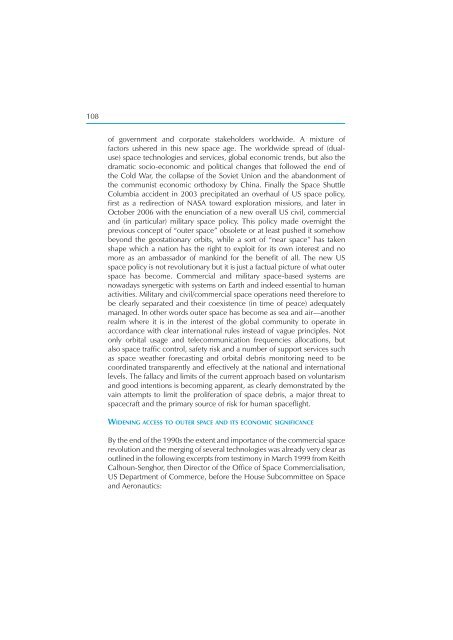Security in Space The Next Generation - UNIDIR
Security in Space The Next Generation - UNIDIR
Security in Space The Next Generation - UNIDIR
You also want an ePaper? Increase the reach of your titles
YUMPU automatically turns print PDFs into web optimized ePapers that Google loves.
108<br />
of government and corporate stakeholders worldwide. A mixture of<br />
factors ushered <strong>in</strong> this new space age. <strong>The</strong> worldwide spread of (dualuse)<br />
space technologies and services, global economic trends, but also the<br />
dramatic socio-economic and political changes that followed the end of<br />
the Cold War, the collapse of the Soviet Union and the abandonment of<br />
the communist economic orthodoxy by Ch<strong>in</strong>a. F<strong>in</strong>ally the <strong>Space</strong> Shuttle<br />
Columbia accident <strong>in</strong> 2003 precipitated an overhaul of US space policy,<br />
fi rst as a redirection of NASA toward exploration missions, and later <strong>in</strong><br />
October 2006 with the enunciation of a new overall US civil, commercial<br />
and (<strong>in</strong> particular) military space policy. This policy made overnight the<br />
previous concept of “outer space” obsolete or at least pushed it somehow<br />
beyond the geostationary orbits, while a sort of “near space” has taken<br />
shape which a nation has the right to exploit for its own <strong>in</strong>terest and no<br />
more as an ambassador of mank<strong>in</strong>d for the benefi t of all. <strong>The</strong> new US<br />
space policy is not revolutionary but it is just a factual picture of what outer<br />
space has become. Commercial and military space-based systems are<br />
nowadays synergetic with systems on Earth and <strong>in</strong>deed essential to human<br />
activities. Military and civil/commercial space operations need therefore to<br />
be clearly separated and their coexistence (<strong>in</strong> time of peace) adequately<br />
managed. In other words outer space has become as sea and air—another<br />
realm where it is <strong>in</strong> the <strong>in</strong>terest of the global community to operate <strong>in</strong><br />
accordance with clear <strong>in</strong>ternational rules <strong>in</strong>stead of vague pr<strong>in</strong>ciples. Not<br />
only orbital usage and telecommunication frequencies allocations, but<br />
also space traffi c control, safety risk and a number of support services such<br />
as space weather forecast<strong>in</strong>g and orbital debris monitor<strong>in</strong>g need to be<br />
coord<strong>in</strong>ated transparently and effectively at the national and <strong>in</strong>ternational<br />
levels. <strong>The</strong> fallacy and limits of the current approach based on voluntarism<br />
and good <strong>in</strong>tentions is becom<strong>in</strong>g apparent, as clearly demonstrated by the<br />
va<strong>in</strong> attempts to limit the proliferation of space debris, a major threat to<br />
spacecraft and the primary source of risk for human spacefl ight.<br />
WIDENING ACCESS TO OUTER SPACE AND ITS ECONOMIC SIGNIFICANCE<br />
By the end of the 1990s the extent and importance of the commercial space<br />
revolution and the merg<strong>in</strong>g of several technologies was already very clear as<br />
outl<strong>in</strong>ed <strong>in</strong> the follow<strong>in</strong>g excerpts from testimony <strong>in</strong> March 1999 from Keith<br />
Calhoun-Senghor, then Director of the Offi ce of <strong>Space</strong> Commercialisation,<br />
US Department of Commerce, before the House Subcommittee on <strong>Space</strong><br />
and Aeronautics:








